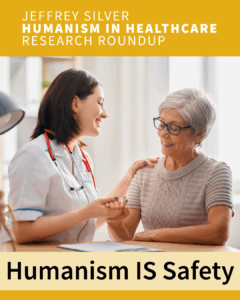
The Jeffrey Silver Humanism in Healthcare Research Roundup features summaries of recently published studies on humanism in healthcare. To receive email notification of new studies once per month, enter your information here and select “Jeffrey Silver Research Roundup” from the checkboxes at the bottom. See previous posts in this series.
Publications from Gold-Affiliated Authors
Patient-hematologist discordance in perceived chance of cure in hematologic malignancies: a multicenter study Loh KP, Xu H, Back A, Duberstein PR, Gupta Mohile S, Epstein R, McHugh C, Klepin HD, Abel G, Lee SJ, El-Jawahri A, LeBlanc TW. Cancer. 2019 Dec 6. Drs. Ronald Epstein and Anthony Back are Mapping the Landscape grantees.
Hematologic malignancies are a group of cancers that can be potentially cured with recent advances in therapeutics. However, the choice to pursue treatment is highly individualized and dependent on close coordination between the patient and the hematologist. But over 80% of patients have a different understanding of their prognosis than their hematologists, with a higher expectation of cure. Kah Poh Loh and colleagues looked at what drive these discordances and how consultation with a hematologist can help bridge them. They asked 209 patients and 46 hematologists at 4 sites their perceived chance of cure, both before and after consultation. They found that consultation reduced the presence of major discordance, but only from 61% to 50%. Lower socioeconomic level, higher social support-affection, and discordance before consultation were significantly associated with greater discordance after consultation. The investigators note that improving practitioner communication skills and developing a better understanding of how these factors contribute to these discordances are key towards guiding further interventions.
Prevalence and predictors of burnout among hospice and palliative care clinicians in the U.S. Kamal AH, Bull JH, Wolf SP, Swetz KM, Shanafelt TD, Ast K, Kavalieratos D, Sinclair CT. J Pain Symptom Manage. 2019 Nov 25. Dr. Arif Kamal is a Mapping the Landscape grantee.
Burnout is a major problem among palliative care physicians as they manage patients who experience significant suffering. But how prevalent is it? And what drives burnout among them? To shine light on this, Arif Kamal and colleagues sent a survey to 4456 members of the American Academy of Hospice and Palliative Medicine (AAHPM). Among the 1357 responses (30% response rate), they found that the burnout rate was 38.7%. Emotional exhaustion was the major driver for burnout. More specifically, factors like non-physician clinical roles, working in smaller organizations, working longer hours, being younger than 50 yeas of age, and working weekends were implicated. While intriguing, the authors note that results may not necessarily be generalizable due to the low response rate and demographic differences between the sample and the entire population of AAHPM members. Nevertheless, it highlights that burnout is highly pervasive and that there is an urgent need for strategies to mitigate its negative effects.
A cross-sectional study exploring the relationship between burnout, absenteeism, and job performance among American nurses Free full text Dyrbye LN, Shanafelt TD, Johnson PO, Johnson LA, Satele D, West CP. BMC Nurs. 2019 Nov 21;18:57. Drs. Lotte Dyrbye, Colin West and Tait Shanafelt are Mapping the Landscape grantees.
Burnout among nurses in the United States is estimated to be about 35 to 45% and has been associated with lower willingness to lead, suboptimal quality of patient care, lower inpatient satisfaction ratings, more health care-associated infections, and increased patient mortality ratios. But little is known about how nurse burnout affects absenteeism and work performance. Liselotte Dyrbye and colleagues examined this by surveying 3098 nurses randomly selected from a large nationwide database. 812 responded (26.2%), of which 35.3% reported symptoms of burnout. These nurses who had burnout were more likely to have one or more absence in the last month, and poor work performance in the last month. Additionally, nurses who were more fatigued were more likely to have had absenteeism while those who worked more hours were less likely to have absences. The authors conclude that organizational investments into improving well-being may boost productivity and result in a positive return on investment.
Coaching primary care clinicians in the ambulatory setting: direct observation and deliberate practice Crocetti M, Kumra T, Fingerhood M, Peairs K, Wolfe L, Wright SM. Fam Med. 2019 Nov;51(10):830-835. Dr. Scott Wright is a Mapping the Landscape grantee.
Feedback is an essential component of medical education that ties current performance to future aspirational performance. One way of delivering feedback is through clinical coaching programs that promote direct observation and reflection. To determine the viability of this approach, Michael Crocetti and colleagues developed a 31-item binary behavioral checklist. Four faculty physicians then used this checklist to observe 18 community-based primary care clinicians across 36 patient encounters. In this checklist, ‘reflects compassion’ and ‘appears to enjoy caring for the patient’ were seen in 100% of encounters. Conversely, ‘assessing understanding,’ ‘acknowledges computer and/or explains role in patient care,’ and ‘apologizes for running behind schedule’ was only seen in 7%, 14%, and 18%, respectively. While a small sample, the authors conclude that observation-based coaching, using simple tools like this checklist, is a viable method to promote feedback and reflective practice.
The association between perceived electronic health record usability and professional burnout among U.S. physicians Free full text Melnick ER, Dyrbye LN, Sinsky CA, Trockel M, West CP, Nedelec L, Tutty MA, Shanafelt T. Mayo Clin Proc. 2019 Nov 12. Drs. Tait Shanafelt and Lotte Dyrbye are Mapping the Landscape grantees.
Over the past decade, Electronic Health Records (EHR) have nearly completely replaced manual record-keeping, leading to major changes in the way that physicians interact with their work environments. Poor usability of EHR’s have been associated with physician dissatisfaction, and it has been hypothesized that it may contribute to burnout as well. Edward Melnick and colleagues set out to test this hypothesis by conducting a cross-sectional survey evaluating EHR usability (through the System Usability Scale) and burnout symptoms (via the Maslach Burnout Inventory). They invited 30 456 physicians to participate, of which 5197 (17.1%) completed the surveys. Overall, EHR usability was rated on average as very poor (Grade F) and varied considerably with respect to specialty and practice setting. After adjusting for these personal and professional characteristics, the odds of burnout were 3% lower for each 1 point more favorable SUS score. These findings provide a basis for further research on whether interventions to improve EHR usability may improve burnout.
Association between physician depressive symptoms and medical errors: a systematic review and meta-analysis Free full text Pereira-Lima K, Mata DA, Loureiro SR, Crippa JA, Bolsoni LM, Sen S. JAMA Netw Open. 2019 Nov 1;2(11):e1916097. Karina Pereira-Lima, Dr. Mata, Dr. Sonia Loureiro, and Dr. Srijan Sen are Mapping the Landscape grantees.
Medical errors account for the premature deaths of as many as a 250,000 hospitalized patients per year. Among the many potentially modifiable contributors, depressed mood among practitioners has been associated. To identify the magnitude of this risk, Karina Pereira-Lima and colleagues conducted a systematic review and meta-analysis of 11 studies involving 21,517 physicians. They calculated the overall relative risk for medical errors who screened positive for depression was 1.95, indicating a higher risk for medical errors among those with the positive screen. Among the four studies that were longitudinal, the relative risk of subsequent perceived medical errors in physicians with depressive symptoms was 1.67. This suggests that the relationship is likely bidirectional. The authors conclude that further research is needed to characterize the roles of cultural and socioeconomic aspects as well as effects of interventions.
Political events and mood among young physicians: a prospective cohort study Free full text Frank E, Nallamothu BK, Zhao Z, Sen S. BMJ. 2019 Dec 9;367:l6322. Dr. Srijan Sen is a Mapping the Landscape grantee.
Increasing lines of data suggest that young physicians are under a lot of stress and are at increased risk for mental health issues. While there exists a body of research about these stressors within the workplace, less is known about exogenous stressors like dramatic societal and political events. Elena Frank and colleagues used mood data from the Intern Health Study between 2016 and 2018 to investigate how political events impact changes in mood. They identified 9 selected political events and 8 non-political events between 2016 and 2018, and compared the mean mood scores four weeks before these events with mood scores one week after. They found that 6 out of the 9 political events led to statistically significant changes in mood, compared to none in response to nonpolitical events. This study highlights the need to better study how these exogenous factors impact mental health and how we can be more responsive to physician needs to such exogenous factors.
Other Publications
Compassion fatigue in healthcare providers: a systematic review and meta-analysis Cavanagh N, Cockett G, Heinrich C, Doig L, Fiest K, Guichon JR, Page S, Mitchell I, Doig CJ. Nurs Ethics. 2019 Dec 12:969733019889400.
Compassion fatigue is the diminished capacity to care as a consequence of repeated exposure to the suffering of patients. It is associated with increased rates of absenteeism, reduced service quality, low levels of efficiency and high attrition rates. Therefore, identifying the prevalence and causes of compassion fatigue is extremely important. Towards those ends, Nicola Cavanagh and colleagues undertook a systematic review and meta-analysis of 71 articles that used the Professional Quality of Life (ProQOL) scale to characterize compassion fatigue. They found that the high scores on the burnout subscale of the ProQOL had the most potentially significant impact on compassion fatigue across studies. Personal factors such as an existing diagnosis of anxiety or depression and prior negative life were also associated with compassion fatigue. Because prevalence is highly variable and its relationship to demographic, personal, and professional variables is inconsistent, the authors stress that approaches to addressing compassion fatigue have to be setting-specific.
To receive an email update when next month’s Research Roundup is published, please click here and check the box for Research Roundup.


